|
Clan Cunningham
Gathering 2003 at Balgonie
Castle
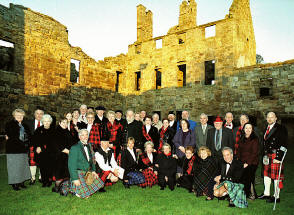
by Larry A. Augsbury, High Commissioner of Clan
Cunningham.
Members of the Clan Cunningham Society of America
(CCSA) from the U.S., Scotland and France gathered together with
their British cousins from the newly formed Society of the Earl of
Glencairn of Cunningham (SEGC) at Balgonie Castle - hosted by Laird
Balgonie, his wife, and son Balgonie the Younger - on Thanksgiving
Day, November 27, 2003, for the first Clan Cunningham Gathering in
well over 200 years to celebrate the ties that bind and unite this
ancient Clan of Scots together.
The gathering included a Thanksgiving feast in the
Great Hall and a tour of the castle and grounds. The clan meeting in
the chapel included the presentation of awards by both SEGC and
CCSA. A basket-hilt sword was awarded to Frances Powers for first
place in the contest on Scottish history. Another sword went to
Daniel and Christine Cunningham and Alva Shoemaker. A sword was also
presented to Laird Balgonie. The Preceptor’s sword from SEGC was
presented to Larry Augsbury for his service to Clan Cunningham. CCSA
Clansman and Clanswoman of the year awards went to Alec Cunningham
and Frances Powers for their exemplary service, dedication and
commitment to Clan Cunningham. Following the awards, the SEGC
Preceptor’s Address focused on the theme of involvement for 2004.
The High Commissioner’s Keynote Address touched on the past, present
and future of Clan Cunningham and CCSA. An excerpt from that address
follows: “All organizations face difficult choices and must cope
with change in order to grow, prosper and continue to deliver the
services for which it was created. Clan Cunningham Society of
America is an all volunteer, non-profit institution formed for the
purpose to discover, promote and share our history and traditions in
order to educate, inform and increase our membership so that we may
encourage and inspire participation in, enhancement of, and most
importantly, enjoyment of our common heritage for present and future
generations. In April of 2002, following inactivity and management
setbacks, CCSA underwent a reorganization to reestablish our
commitment and service to our society and its members. As an all
volunteer organization, it is an ongoing challenge to meet the
demands of managing our active society, in a timely and responsive
manner, with the level of service and quality that our members
deserve, and to meet the standard of excellence which is the legacy
left to us by the centuries of exemplary service to God, country,
and kin, by our dignified ancestors, the Earls of Glencairn, and
their forefathers before them. This challenge is met by dedicated
Cunninghams who invest their invaluable time to discover their rich
heritage and share it with their extended Cunningham family
world-wide.
There is much more for us to do on behalf of Clan
Cunningham. Whatever we accomplish, at whatever pace it is achieved,
depends on all of you. Just a few years ago, I decided to volunteer
some of my time to Clan Cunningham. I was astonished by how much I
enjoyed my involvement, which started out slowly and steadily grew.
Early on, I thought I was too busy to volunteer. But as I began to
interact within our society, within our Cunningham Clan, and within
the Scottish Community at large, many lasting friendships have
developed. As I continue to learn about our heritage, and continue
to meet fascinating people from around the world, I realize that
Clan Cunningham is so much more than just an amusing distraction, a
pastime, or a hobby. It is my extended family. As such, I look
forward with pleasant anticipation to future collaboration with the
Society of the Earl of Glencairn of Cunningham, who have done a
brilliant job of organizing this Gathering. I’d like to thank
members François and Marie-Thérèse Redien for the marvelous St
Andrew Soirée at the Château de Cherveux, and members Jim and Julie
Hutchison of Villeneuve, France for their generous hospitality and
participation. I look forward with eager anticipation to a future of
interacting with the members of our global and united Cunningham
family, and dare I hope, under the direction of our next rightful
and recognized Clan Chief. And, I am especially delighted to share
the pleasure of the company of all of you here at Balgonie Castle
for this International Clan Cunningham Gathering 2003.”
The evening’s Balgonie festivities concluded in the
Great Hall with entertainment provided by the Piper Leslie
MacKinlay, Magician Steve Lindsay and Highland Dancers Claire and
Melonie Reekie.
Saint Andrew’s Night -
Château de Cherveux
by Larry Augsbury, High Commissioner of
the Clan Cunningham Society of America, Inc. (CCSA)
For the first leg of the Clan Cunningham
International tour last November, I found myself arriving at the
home of CCSA members François and Marie-Thérèse Redien, at their
Château de Cherveux, about 11 pm to a flood-lit fifteenth century
castle shrouded in a dense fog. I thought I could hear the faint
pounding of hoofs approaching through the mist as though Robert de
Conyngham, Captain of the Scots Guard and King’s Bodyguard for
French Kings Charles VII and Louis XI, would lead his steed past us
as we crossed the stone bridge that spanned the moat and led through
the outer wall of the fortifications, past the Guard House and into
the courtyard of the castle Robert de Conyngham built 533 years
earlier. At that point the surreal mélange of past and present-day
Clan Cunningham events began to intertwine and coalesce into an
unforgettable series of momentous occasions.
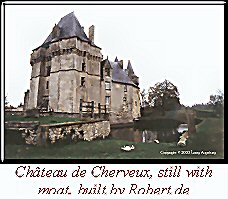 The
next morning we toured the château, its grounds and had an
opportunity to briefly visit the town of Cherveux before a local
television reporter arrived to film a piece on the St. Andrew’s
Night Banquet and Ball which was taking place that evening, Friday,
November 21st. About fifty reservations were made for the
function including such dignitaries as the current Mayor of
Cherveux, Georges Lair; the former Mayor of Cherveux for 12 years
was François Redien himself; the former French Ambassador to the
U.S., Jeanne Debenest; Academician, Author and Historian of the
French Middle Ages Philippe Contamine; the President of "des Maisons
Paysannes" of Deux-Sèvres, Madeleine Audebrand; the President of the
“société d'assurance Groupama" of Deux-Sèvres, Joseph Godet; Marc
Thébault, Municipal Councillor of Niort and
Parlimentary Attaché of Senator André Dulait; and the Vice-President
of the Conseil Général des Deux-Sèvres and Mayor of Saint-Maixent,
Léopold Moreau. Even the French Prime Minister Jean-Pierre Raffarin
and Senator André Dulait were invited, but had to decline due to
prior engagements. The
next morning we toured the château, its grounds and had an
opportunity to briefly visit the town of Cherveux before a local
television reporter arrived to film a piece on the St. Andrew’s
Night Banquet and Ball which was taking place that evening, Friday,
November 21st. About fifty reservations were made for the
function including such dignitaries as the current Mayor of
Cherveux, Georges Lair; the former Mayor of Cherveux for 12 years
was François Redien himself; the former French Ambassador to the
U.S., Jeanne Debenest; Academician, Author and Historian of the
French Middle Ages Philippe Contamine; the President of "des Maisons
Paysannes" of Deux-Sèvres, Madeleine Audebrand; the President of the
“société d'assurance Groupama" of Deux-Sèvres, Joseph Godet; Marc
Thébault, Municipal Councillor of Niort and
Parlimentary Attaché of Senator André Dulait; and the Vice-President
of the Conseil Général des Deux-Sèvres and Mayor of Saint-Maixent,
Léopold Moreau. Even the French Prime Minister Jean-Pierre Raffarin
and Senator André Dulait were invited, but had to decline due to
prior engagements.
The Saint Andrew’s Night began with cocktails and
hors d’oeuvres in the Guard House. Then the guests were piped across
the courtyard into the Great Hall and welcomed by François Redien.
The Selkirk Grace was delivered by Tony Murdock. The dinner menu
consisted of: Cockaleekie Soup, Smoked Scottish Salmon, Wild Boar
filet, Scottish and French cheeses, Cranachan dessert
The Robert Burns poem “Lament to James, Earl of
Glencairn” was read by Scottish CCSA member Jim Hutchison. There
were three toasts proposed. Tony Murdock delivered the toast to
Saint Andrew. François Redien gave the toast to the “Auld Alliance”
between Scotland and France. I proposed the toast to Scotland which
I delivered in both English and French as follows:
“Scotland has had a significant impact on both of
the great nations of France and America. When over 1/2 of France was
under English control during the fifteenth century, following the
Scots defeat of the English at Vieil Bauge, Pope Martin V is said to
have declared: “The Scots are an antidote to the English!” In the
aftermath of a victory during the campaign of Joan of Arc to lead
the Dauphin, Charles Valois, to Rheims for his coronation as King of
France, she galloped her horse to the Scots and praised them with
her famous line: ‘You
Scots make good war!’ Scotland’s influence on
America’s struggle for independence and the formation of the free
government of the Unites States cannot be overemphasized. Well over
1/3 of the signers of the American Declaration of Independence were
of Scottish descent. George Washington, Father of the United States,
Commander-in-Chief of the Colonial Forces, first President of the
United States of America, whose ancestry has been traced back to
Scottish King Malcolm II, chose as his first cabinet, Edmund
Randolph as Attorney General, Henry Knox as Secretary of War,
Alexander Hamilton as Secretary of Treasury and Thomas Jefferson as
Secretary of State, all of Scottish descent. Thomas Jefferson, third
President of the USA, American Minister to France, a descendant of a
sister of King Robert I of Scotland, was the author of the American
Declaration of Independence, which bears remarkable similarities, in
wording and aspirations, to a document written 456 years earlier,
the Declaration of Arbroath of Scotland. Ladies and Gentlemen,
charge your glasses and be upstanding. To Scotland.”
On behalf of Clan Cunningham, I then presented a gold
foil-stamped, leather hard-backed bound French translation of the
new edition of our Clan Cunningham Origins, Heritage and Traditions
book, with a new chapter dedicated to the Scottish/French "Auld
Alliance", as a gift to François for display and reference in the
Château de Cherveux to inform guests of its Cunningham origins.
An evening of pleasant conversation in both French
and English accompanied by music and dancing followed which went
well into the wee hours.
John Cunningham, 15th
Earl of Glencairn, Memorial Dedication Ceremony
On Tuesday, November 25, 2003 the Clan Cunningham
Society of America (CCSA) dedicated the granite memorial that
they designed, commissioned and had erected at his resting place
to honor the memory of the last Clan Cunningham Chief and 15th
Earl of Glencairn, John Cunningham, who was interred at St.
Cuthbert’s Churchyard below Edinburgh Castle and adjacent to
Princess Gardens in Edinburgh, Scotland on September 29, 1796.
His original tombstone was inexplicably missing from the wall
behind his grave and CCSA has now restored the dignity and honor
of our last Clan Chief’s grave and established a focal point
from which Clan Cunningham can rise and reclaim its rightful
place among the contemporary clans of the twenty-first century.
Memorial Artist and Sculptor, Roger Seal of
Denver, CO, carved the Glencairn Arms, which was commissioned
from the Lord Lyon King of Arms, specifically for this monument
whose dedication ceremony began at 10:30 AM.
The proceedings of the Memorial Dedication
Ceremony presented by CCSA went as follows:
PIPER’S LAMENT 'Mist Covered Mountains
of Home' by Piper Keith Easdale.
OPENING COMMENT AND INTRODUCTIONS by MODERATOR,
Larry Augsbury, High Commissioner, Clan Cunningham Society of
America
“MALCOLM’S RIDE” A ballad of the origins of the
motto and shake-fork charge on the Glencairn Arms of Clan
Cunningham, performed by internationally
renowned Celtic group CALASAIG: Keith Johnston,
Kirsten Easdale, Keith Easdale, Celine Donoghue and Andy
Webster.
HONORED GUEST’S ADDRESS, Lord Lyon King of Arms
of Scotland, Right Honourable Robin Blair, LVO, WS:
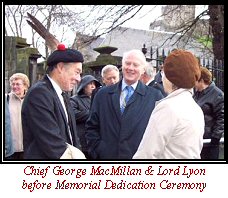 “Ladies
and Gentlemen, “Ladies
and Gentlemen,
We are here
today on an important day for Clan Cunningham. The clan has been
without a leader since the death of the fourteenth Earl of
Glencairn in 1796. The clan of course is led by its present High
Commissioner, but that is not the same as having a chief.
Of course there
are a large number of other clans who do not have a chief at
present. Any such clan has the disadvantage of not having a
clear leader about whom the members of the clan can rally. The
Cunninghams are better placed than many in having a clan society
that is active and which serves to maintain the clan’s history,
memories, and fellowship.
I wish you well
at your International Gathering. What you are doing today is
creating in Scotland a physical focus at the grave of the last
clan chief. That will be a valuable point of reference for the
future. It was for these reasons that I welcomed the initiative
which Mr. Augsbury proposed when he wrote to me in August of
last year, asking for my views on the possibility of having this
memorial created which is being dedicated today. I am very
pleased indeed that this initiative has come to fruition.
The title Earl
of Glencairn is very ancient, dating from 1488, but we know very
little about John Cunningham, the fourteenth Earl. We know that
he was born on the 17th of May, 1750. As a young man he enjoyed
the social life of an officer of the 14th Regiment of Dragoons.
There is no record that he saw active service. He then took holy
orders in the Church of England, but again there is no record of
his having taken up a position within a parish of the Church of
England. I was in contact recently with a repository of
historical information about all ordained ministers in the
Church of England, but they were unable to tell me of any parish
where the Reverend Cunningham had served.
He was married
to Isabella Erskine, daughter of the Earl of Buchan. He died in
Coates in West Edinburgh, which had been the Glencairn home for
many years on the 24th of September, 1796. He and his wife had
no children.
John Cunningham
was somewhat eccentric and had a mind full of fantasies. He is
said to have been the author of a drama in twenty-five acts
which was performed in Aberdeen. The play opens with Adam and
Eve stark naked. So, it must have been something to remember.
After his death, no relative was found to inherit the Earldom
and the chiefship of the clan.
Despite the
scarcity of our knowledge about him, it is good that this
memorial has been created as a permanent reminder of the life of
this gentleman and his importance to Clan Cunningham. I am most
grateful to you for inviting me to make these remarks and for
being here on this important occasion.”
Transcribed by Alec & Bill Cunningham
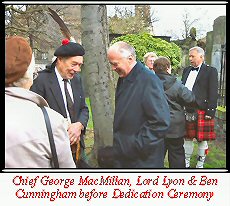 SPECIAL
GUEST SPEAKER Clan Chief George MacMillan of MacMillan and Knap
of Finlaystone (former seat of Clan Cunningham) SPECIAL
GUEST SPEAKER Clan Chief George MacMillan of MacMillan and Knap
of Finlaystone (former seat of Clan Cunningham)
“I think my brief is to talk about the
Cunninghams and Finlaystone, which is where I live. It is a
house now, but it was once a castle on the banks of the Clyde.
The Cunningham connection with Finlaystone is of
course in someway peripheral to the grand history of the
Cunningham clan. It was only one of many houses they owned and
occupied at various times. I think the normal plan was to go
around to your various houses eating up the rent. Finlaystone
was regarded as one of the main ones.
I regret to tell you the Cunninghams were what we
might call opportunists. In the west of Scotland the word
"Chancellor" is often used for people who see an opportunity and
take advantage of it. The two ways they did this was first by
marriage, and the other one of course was by force of arms. I
think on the whole they were more successful with their
marriages, but they did occasionally venture into Scottish
history at crucial moments and were extremely important in their
field.
Who am I to talk about Chancellors because my
father was a soldier and he gained Finlaystone by marriage, so I
am very much in the mission of the Cunningham family. The first
Cunningham of Finlaystone was William, who got it in 1404 from
the Danzielstone or Danielstoun family, who must have owned vast
tracks of Scotland, and who in fact had two castles, almost
adjacent. One was called Finlaystone
and the other was called "Nether
Finlaystone," which is only about four miles away and is still
more or less in its original form. So, when you come over to our
side of the world, if you would like to go down to Nether
Finlaystone, which is now called Newark castle, you will see
what Finlaystone might have been like in the 15th Century.
Jane and I were in Machu Picchu not very long ago
and we were very surprised to find that the great stones of
Machu Picchu were only put in place about the same time
Finlaystone and Nether Finlaystone were being built. There is
sort of an historical perspective there to be born in mind.
I will not go through all the Earls because there
are far too many of them, but one is quite worth touching on. We
who live in Finlaystone always regard James, the patron of Burns
as the Fourteenth Earl and John as the Fifteenth, and we
recognize there is quite a bit of blather about all that. I
think it happened very early on because rather sadly the first
Earl, Alexander, was killed very soon after he was created Earl
at the battle of Sauchieburn. Unfortunately, he was on the
losing side. He had been badly wounded. [The battle was between
James III and James IV of Scotland, and pitted] Father against
son, sorry to say. The father lost. The son became James IV and
deprived Alexander's son of his title, the Earl of Glencairn. I
think it was from this that the numbering became so disjointed.
But anyhow, terribly more interesting than the
numbers are the characters themselves. On the whole, it is the
odd numbered Earls that seem to feature most prominently. The
Fifth Earl I suppose you could call him the patron of John Knox.
In 1556 John Knox visited Finlaystone and held the first formal
communion in Western Scotland. That was a pretty bold thing to
do at the time for the times were very tumultuous. One of Knox's
predecessors had been slaughtered. I think the Earl took rather
good care to get a few other Earls involved. Certainly one was
of close relation by marriage, the Earl of Arran.
Just an illustration of how precarious things
were, it was not very long before this that the Earl's father
had been at odds with the Earl of Arran, and it sort of
surprised everybody that Alexander actually married the Earl of
Arran's daughter. The marriage was one example of many where a
marriage was the cement joining the grand families of Scotland
together. The Earls through marriage acquired enormous parcels
of land. That was an example of how quickly they could change
their allegiance, from hatred to marriage, and sometimes the
other way around, I am sad to say.
Another good example of that was perhaps the most
favorable of all, the Seventh Earl of Glencairn. He took part in
a rather peculiar skirmish in Kilbarchan which is a small
village just to the south of Finlaystone, and it in fact took
place at the parish church. It was a rift involving the property
of a Finlaystone neighbor, Mr. Porterfield. The Porterfields
were a powerful lowland clan, and unfortunately for the
Cunninghams, Mr. Porterfield failed to pay his rent. This I
regret to say resulted in a skirmish, beginning in the
churchyard of Kilbarchan parish church just after Sunday
worship. Sadly, the Cunninghams had to run for it, about three
miles, mainly up hill to Finlaystone. They managed to get home
and barricade themselves in. But they were never terribly fond
of the Porterfields and smarted over this skirmish and so they
ransacked the Porterfield's stronghold Duchal House. It was not
too long after that, so the story goes, that the same James was
caught in a very bad storm not very far from Duchal and knocked
at the door asking for refuge from the storm, which the
Porterfield very generously gave him. So, you just never really
knew where you were with anyone at all at any time.
A final story about James is rather ironic in a
way because if you walk around Edinburgh, you will find opposite
one another the Glencairn pursuivant and the Eglinton pursuivant
(coat of arms).
The Cunninghams were the Earls of Glencairn and
the Montgomeries were the Earls of Eglinton in Ayrshire. They
had a rather long running dispute, a rather curious one that may
appeal to the Lord Lyon. He probably knows about this anyway. A
small landed Earl had a right to dispense justice in that area
of Scotland. The Cunninghams it seemed were prepared to stop at
nothing to gain this privilege. They actually murdered one of
the Earls of Eglinton, Fat Hugh he was called. I am sure the fat
part was a bit of spin to show how unworthy he was to sit on the
bench.
Anyhow, he was murdered. James originally
disclaimed any knowledge of the conspiracy, but there is no
smoke without fire, as they say. So there was conflagration and
marriage, and this went on through the next two or three
centuries.
The 9th Earl is a very crucial one. He may well
figure as the eighth in your history. He had a most difficult
time because he was living during the time of the English Civil
War. Things were complicated enough in England, but in Scotland,
they were almost impossible because the church was involved in
it. The Glencairns, as you may have realized by now were very
generally speaking on the side of the Presbyterians, with John
Knox and his side. The king, unfortunately, was on the rather
High Anglican side.
Added to that, the ninth Earl wanted to support
the church, but he also wanted to support the king because he
thought it might suit him quite well. Besides that, the Earl of
Argyll, whom everyone hated, decided to change sides halfway
through, so everyone else had to change sides too. So, it was
quite impossible to sort out who was on which side. The upshot
of it was that the 9th Earl got himself locked up in Edinburgh
Castle right at the end of the Times of Trouble and was in fact
due for an untimely death when the bell rang and Charles the II
was restored to the throne and out he (9th Earl) popped and
became Lord High Chancellor of Scotland.
That was not quite the end of the story because
he was then given the job of ousting Presbyterians, which he did
not find very tasteful. It is said on his deathbed, after a
slightly dubious sexual life, he offered to let some
Presbyterians in to see him off to the next life, which prompted
someone to say "a Scotsman, whatever he is during most of his
life, is usually discovered to be a Presbyterian in the end." He
found himself buried in St. Giles Cathedral, just up the hill
there. Actually, forgive me if you will, under the car park
outside.
May I just finish by thanking the opportunistic
Cunninghams for their gracious hospitality, from one opportunist
to another. Thank you very much.”
Transcribed by Alec
& Bill Cunningham
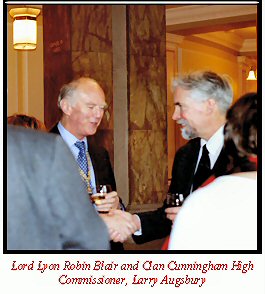 SPEAKER,
Edinburgh City Councillor, Bill Cunningham, Holyrood Ward. SPEAKER,
Edinburgh City Councillor, Bill Cunningham, Holyrood Ward.
MODERATOR’S ADDRESS, High Commissioner, Larry
Augsbury, Clan Cunningham Society of America:
RECITATION OF ROBERT BURNS POEM, “LAMENT FOR
JAMES, EARL OF GLENCAIRN,” Read by James Hutchison.
PROCESSION TO GRAVESITE AND MEMORIAL TO JOHN,
EARL OF GLENCAIRN.
Procession piped to the tune 'March of
the Cunningham's' written, piped and performed for the first time ever by Keith Easdale
specifically for this occasion of the
processional walk to the graveside and memorial of John, Earl of
Glencairn and Clan Cunningham Chief.
PIPER’S LAMENT
'Sleep Dearie Sleep'
by Piper Keith Easdale
BLESSING OF MEMORIAL by Reverend T. C. Cuthell of
St. Cuthbert’s Parish Church.
THE CITY OF EDINBURGH hosted a civic reception
for Clan Cunningham at Usher Hall following the memorial
dedication ceremony with music performed by Calasaig.
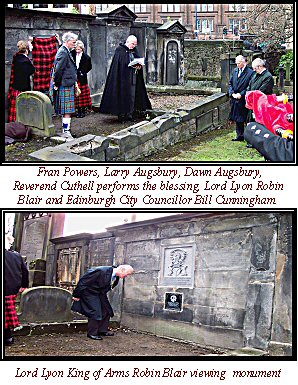
|

